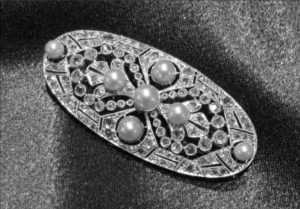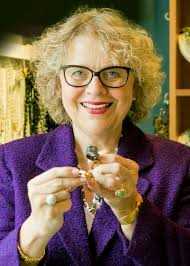The beginning of the 20th century, a period of great upheaval

The 1900s are the Paris World Fair, the first flight of Brother Wright, the Scheherazade ballet of the Russian Serge de Diaghilev, the invention of the automobile by Henry Ford, the creations of the architect Frank Lloyd Wright , the new painting by Gustav Klimt and Alfons Muchas. It is also Marcel Proust in literature, Sigmund Freud for psychoanalysis. It’s the advent of cinema, the music of Claude Debussy, the birth of radio…
Two emerging movements coexist: Art Nouveau in France and Arts and Crafts in England
The beginning of the twentieth century is experiencing major upheavals in society. Art does not escape. In design, two coexisting movements are emerging in Europe: avant-garde jewelers work in Art Nouveau styles in France (but also elsewhere in Europe and the United States) and Arts and Crafts in England.
Samuel Bing, passionate about Japanese art, established the House of Art Nouveau, in 1895, in Paris. The word is launched! It will be the era of Art Nouveau in France!
On the jewelery side, the change emerges mainly from the desire of the jewelers to focus on the artisanal design rather than on the value of the stones used. A new naturalistic approach brings such motifs as the female face framed by long wavy hair, the female body 9nu or half-naked), flowers (orchids, water lilies, lily of the valley), insects (dragonflies, butterflies, bees), birds (peacocks, swallows, swans), the vine encircling tree trunks, snakes (symbols of eternal life). The scrolls are present everywhere in the new art; the most famous appear at the entrances to the Paris metro designed by the architect Hector Guimard.
At that time, several plays were created for the theater. Think of the Folies-Bergère, the dancer and courtesan Liane de Pougy, Sarah Bernhardt! The jewels are decorated with rubies and synthetic sapphires, rock crystal, moonstone, lapis lazuli ivory, horn. The enamel is experiencing an important revival thanks to Pierre-Carl Fabergé, jeweler of the family of Nicolas II, last Tsar of Russia.
Other masters have been recognized in Art Nouveau. In France, René-Jules Lalique, known for his glass work but also for his highly refined jewelry creations, is the essential and dominant figure. Maison Vever, Lucien Gaillard and Georges Fouquet also stood out. In America, Louis Comfort Tiffany is first known for its stained glass and lamps that now bear his name. His jewelry has made him famous around the world.

At the same time, in England, begins the movement of Arts and Crafts better known under the name Arts and Crafts. In reaction to industrialization, the thinkers of this new school want to give back the place to the craftsman. One of his famous instigators is the writer, painter and decorator William Morris.
The typical patterns of Arts and Crafts jewelry are interlaced lines where Celtic knots are in the spotlight. More often in silver, the jewels are decorated with enamels, ivory, horn, mother-of-pearl with satin reflections. Less expensive stones, often carved in cabochons, such as amber, garnet, amethyst, turquoise, are also used. Faceted stones and diamonds are very rarely used by the defenders of this movement.
Jewelers focus on craft design
Making a jewel in the hand is not within the reach of all. In England, two jewelers stand out: Charles-Robert Ashbee and Arthur Lasenby Liberty, owners of the famous Liberty stores. The latter has the brilliant idea of employing in his Birmingham workshop the craftsmen of the guild who draw the models and finish each jewel entirely by hand. Part of the production itself is skillfully done by machine, which ensures a more consistent quality to the final product. This happy experience was taken up by Theodore Fahrner in his workshops in Pforzheim, near Strasbourg, then city of Germany.
Art Nouveau and the Arts and Crafts movement are part of a broad reform that leads to the renewal of aesthetics. At the same time, the upper middle class is elegant and opulent. For ladies, it rhymes with a profusion of lace, silks and exotic feathers. We speak then about the garland style in France and Edwardian in England. The leader of the garland style is without a doubt the Cartier House which brings to its peak the use of diamonds and pearls set delicately in platinum. This style is characterized by a light pattern of festoon leaves and flowers. However, it has gone little beyond the borders of France.
The British Empire is in mourning in 1901; it’s the end of the Victorian era. At age 60, Edward VII finally reaches the throne for the nine

coming years. Alexandra, princess born in Denmark, forms with the king a couple already famous in Paris of the Belle Epoque. Alexandra forgives Edward’s infidelities and makes his mark in the world of fashion. It makes popular the dog necklace, a wide jewel worn tight around the neck, sometimes formed of several rows of pearls or often a velvet or silk ribbon. It is whispered that this elegant hiding and a scar …
Diamonds essential to Edwardian jewelry.
The popular motifs in the Edwardian style are the horseshoe (lucky charm), the bones, the crowns, the bay leaves and the horses with carriage.
Diamonds are essential to Edwardian jewelry, especially since they are now better cut with new techniques. The use of platinum appears in England. Resistant metal, it allows thanks to the crimping of grains to put them in full value.
Other stones are also popular: amethyst, opal, demantoid grenant (brilliant green stone, favorite of Edward VII), kunzite (pink stone, Alexandra’s favorite), peridot.

Around the same time, in Canada, Henry Birks, heir to a long tradition of goldsmiths, developed his company founded in Montreal in 1879. Quickly, and with the help of his three sons William, Massey, Harry and Gerald, he opens a store in every major Canadian city. After Montreal, it’s Ottawa, then as the railroad is built, more and more towards the West. A savvy businessman, William Birks has responded to the growing taste of luxury among Anglophones in Montreal and the rest of Canada. Even today, Montreal is recognized as one of the most important jewelery centers in Canada.
In 1914, the announcement of the First World War in Europe changed the course of history. The energy of men and machines now serves only to feed this monster that is war. In this context of rationing and scarcity, the manufacture of jewelry will remain dormant for the benefit of war production.
Finally, it will be the end of hostilities, the reconstruction of Europe and soon the Roaring Twenties. It was not until the 1920s to see the beginning of a new era, an era of peace where Art Deco flourished and then, shortly after, Retro Art.

